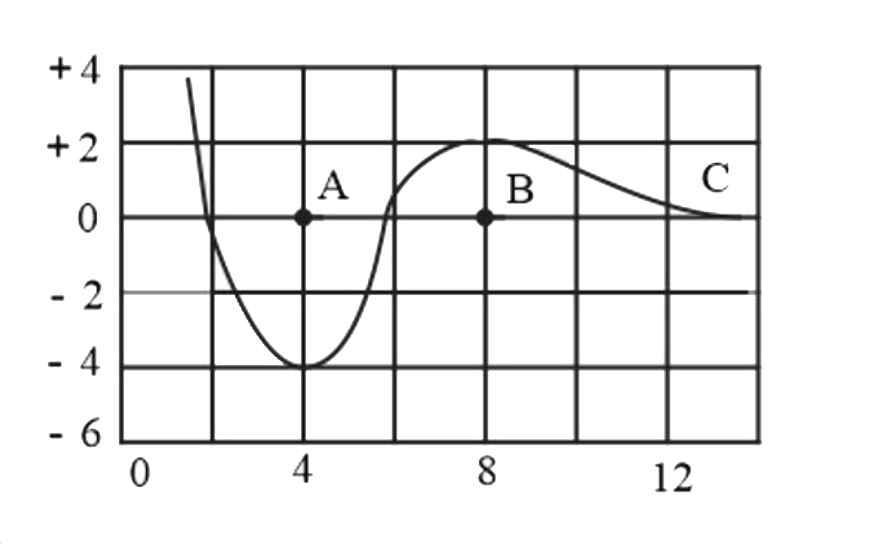STATEMENT-1: If potential energy of a dipole in stable equilibrium position is zero, its potential energy is unstable equilibrium position will be 2pE, where p and E represent the dipole moment and electric field respectively
and
STATEMENT-2 : The potential energy of a dipole is minimum in stable equilibruim positioni and maximum in unstable equilibrium position.
Statement-1 is True, Statement-2 is True, Statement-2 is a correct explanation for Statement-1
Statement-1 is True, Statement-2 is True, Statement-2 is NOT a correct explanation for Statement-1
Statement-1 is True, Statement-2 is False
Statement-1 is False , Statement-2 is True
The correct Answer is:B
To solve the problem, we need to analyze both statements regarding the potential energy of a dipole in electric fields.
Step 1: Understanding Potential Energy of a Dipole
The potential energy (U) of a dipole in an electric field (E) is given by the formula:
U=−→p⋅→E
where →p is the dipole moment vector.
Step 2: Analyzing Stable Equilibrium
In stable equilibrium, the dipole is aligned with the electric field. The potential energy is minimized, and the formula becomes:
Ustable=−pE
If we assume that the potential energy in this position is zero, we can set:
−pE=0
This implies that either p or E must be zero, which is not typical in a dipole scenario. However, if we take the reference point where the potential energy is zero, we can analyze the unstable equilibrium.
Step 3: Analyzing Unstable Equilibrium
In unstable equilibrium, the dipole is oriented opposite to the electric field. The potential energy is maximized, and the formula becomes:
Uunstable=pE
If we consider the potential energy in stable equilibrium as zero, then the potential energy in unstable equilibrium can be expressed as:
Uunstable=2pE
This means that the potential energy in the unstable position is indeed twice that of the stable position.
Step 4: Conclusion
Thus, we can conclude that:
- Statement 1 is true: If the potential energy of a dipole in stable equilibrium is zero, then its potential energy in unstable equilibrium will be 2pE.
- Statement 2 is also true: The potential energy of a dipole is minimum in stable equilibrium and maximum in unstable equilibrium.
Final Answer
Both statements are true.
---
The potential energy (U) of a dipole in an electric field (E) is given by the formula:
U=−→p⋅→E
where →p is the dipole moment vector.
In stable equilibrium, the dipole is aligned with the electric field. The potential energy is minimized, and the formula becomes:
Ustable=−pE
If we assume that the potential energy in this position is zero, we can set:
−pE=0
This implies that either p or E must be zero, which is not typical in a dipole scenario. However, if we take the reference point where the potential energy is zero, we can analyze the unstable equilibrium.
In unstable equilibrium, the dipole is oriented opposite to the electric field. The potential energy is maximized, and the formula becomes:
Uunstable=pE
If we consider the potential energy in stable equilibrium as zero, then the potential energy in unstable equilibrium can be expressed as:
Uunstable=2pE
This means that the potential energy in the unstable position is indeed twice that of the stable position.
Thus, we can conclude that:
- Statement 1 is true: If the potential energy of a dipole in stable equilibrium is zero, then its potential energy in unstable equilibrium will be 2pE.
- Statement 2 is also true: The potential energy of a dipole is minimum in stable equilibrium and maximum in unstable equilibrium.
Both statements are true.
Topper's Solved these Questions
- ELECTROSTATIC POTENTIAL AND CAPACITANCE BOOK - AAKASH INSTITUTECHAPTER - ELECTROSTATIC POTENTIAL AND CAPACITANCE EXERCISE - SECTION-F(MATRIX-MATCH TYPE QUESTIONS)
2 Videos
- ELECTROSTATIC POTENTIAL AND CAPACITANCE BOOK - AAKASH INSTITUTECHAPTER - ELECTROSTATIC POTENTIAL AND CAPACITANCE EXERCISE - SECTION-G(INTEGER ANSWER TYPE QUESTIONS)
8 Videos
- ELECTROSTATIC POTENTIAL AND CAPACITANCE BOOK - AAKASH INSTITUTECHAPTER - ELECTROSTATIC POTENTIAL AND CAPACITANCE EXERCISE - SECTION-D(COMPREHENSION-I)
3 Videos
- ELECTROMAGNETIC WAVESBOOK - AAKASH INSTITUTECHAPTER - ELECTROMAGNETIC WAVESEXERCISE - ASSIGNMENT SECTION - D Assertion-Reason Type Questions
25 Videos
- GRAVITATION BOOK - AAKASH INSTITUTECHAPTER - GRAVITATION EXERCISE - ASSIGNMENT SECTION - D (ASSERTION-REASON TYPE QUESTIONS)
16 Videos
Similar Questions
Knowledge Check
In a conservative field at stable equilibrium potential energy is:
AmaximumBminimumCconstantDmaximum or minimumAssertion :Mean positon of SHM is the stable equlibrium position.
Reason: In stable equilibrium , position potential energy is minimum.AIf both Assertion and Reason are correct and Reason is the correct explanation of Assertion.BIf both Assertion and Reason are correct but Reason is not the correct explanation of Assertion.CIf Assertion is true but Reason is false.DIf Assertion is false but Reason is true.Potential energy of a particle at position x is given by U=x2−5x. Which of the following is equilibrium position of the particle?
Ax=0Bx=5Cx=2.5Dx=7.5
For the potential energy function shown in fig. there will be an unstable equilibrium at position

View SolutionElectric dipole is placed in external electric field. When the potential energy of dipole is maximum?
View SolutionWhat can we conclude for the potential energy of a system in stable equilibrium?
View Solutionwhen an electric dipole is suspended in a uniform electric field, then under what conditions the dipole is in (i) stable equilibrium and (ii) unstable equaliibrium.
View SolutionWhat should be the orientation of a magnetic dipole in a uniform magnetic field so that its potential energy is minimum (or the dipole is in stable equilibrium) ?
View Solution
